Technical Data Drive chain Handling Roller Chains
7. Roller Chain Inspection
- 1. In general, roller chain life is said to be reached when parts are damaged or when 1.5% wear elongation occurs. Try to replace the chain before these conditions occur.
- 2. Wear will progress between the pins and bushes after long periods of use.
7.1 Inspection checklist
| Procedures | Method | Inspection items | Reference page for details |
|---|---|---|---|
| Procedures I | Visually check the chain during operation and look for any abnormalities. |
|
Inspection points are on the following pages and on the troubleshooting pages. |
| Procedures II | Stop the chain and carefully inspect each part of the chain and sprocket. |
|
|
| Procedures III | In order to investigate in more detail, remove the roller chain and inspect it visually or check it with measuring instruments. |
|
7.2 Inspection intervals
Regular inspection of roller chain is recommended at one month intervals.
Inspection should be carried out at shorter intervals in:
- 1. Special or corrosive environments.
- 2. High speeds with sudden stoppage.
- 3. Lifting or indexing operations.
7.3 Inspection requirements for ordinary transmission
1. Inspection lubrication conditions
- 1-1. During operation, check to see if there is lubrication in the clearance between the outer plate and inner plate.
Also, check if the chain or rotating disc is immersed in lubricating oil. - 1-2. The chain surface will generally appear dirty from wear dust if lubrication is unsatisfactory.
This is especially the case between the link plates. - 1-3. When the chain is removed, connecting link pins and the edge of the inside of the bushes should be checked.
If there are any scratches, or red or reddish-brown coloration, lubrication is improper or insufficient.
2. Inspecting link plates
- 2-1. If repeat loads over the maximum allowable load are put on the chain, there is a strong possibility of fatigue breakage of the link plates. It is difficult to notice initial cracking from fatigue breakage simply from external observation.
- 2-2. Usually, a crack develops at the edge of a hole or at the side of the link plate, as shown in Fig. 25. The presence of cracks should be checked carefully. Fatigue breakage progresses little by little, so it can be noticed with close attention.
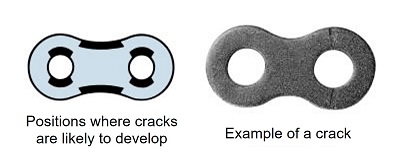
Fig. 25. Cracks on the link plates
- 2-3. When wear occurs from sliding between the edges of the plates and the guides, it is necessary to adjust the position of either the chain or the guides. The allowable wear on the link plates is limited to 5% of their height. (Fig. 26)
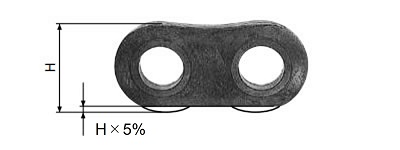
Fig. 26. Wear on the edges of the link plates
3. Inspecting pins
When the pins rotate (Fig. 27), the roller chain must be completely replaced with new chain. This also applies to the connecting pins. By removing the connecting parts it is possible to see the conditions of wear and rust on the surfaces of the pins.
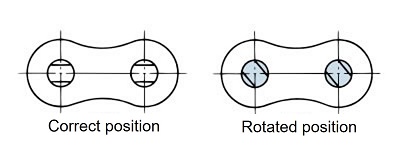
Fig. 27. Rotation of the pins
4. Inspecting rollers
- 4-1. As with the link plates, if rollers are also subjected to loads over the maximum allowable load, the repeated impact load between the chain and the sprockets may cause fatigue breakage to occur.
(Fig. 28)
The roller should be checked in the same way as the link plate.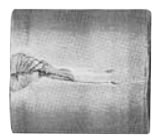
Fig. 28. Cracks on the rollers
- 4-2. If foreign objects interfere with the engagement of the roller and sprocket, the roller may be damaged and a crack may develop. Careful attention should be paid to the above.
Furthermore, with high-speed operations, even if foreign objects do not interfere with engagement, cracks may appear from the impact with the sprocket teeth. - 4-3. Chains damaged by fatigue breakage from the rollers must be completely replaced, as each part has received the same amount of repeated load.
- 4-4. Also check for poor roller rotation.
5. Inspecting sprockets
- 5-1. Chain and sprocket engagement can be checked by observing the roller and teeth surface.
Proper engagement is when the contact area is uniform with point A in Fig. 29.
If the contact area is lopsided or the sides of the teeth are wearing away (point B), this may have been caused from improper installation of the sprockets or twisting of the roller chain. In this case, rechecking/readjustment is necessary. - 5-2. The normal point of impact is slightly up from the tooth root. As shown in Fig. 29, point A receives the strongest impact.
However, when initial tension is applied to the chain and tension remains on the slack side, the roller will slightly touch the tooth root. - 5-3. When idlers or tensioners are used, the contact area will be the center of the tooth root.
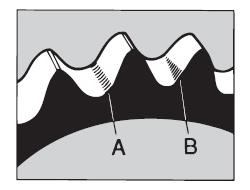
A:Normal B:Improper installation

Improper installation causes the surface of the teeth to become ground down
...Improper installationFig. 29. Contact area of the sprocket teeth
- 5-4. When wear on the teeth reaches the values in the following table, the lifespan of the sprocket has been reached.
For a sprocket with induction hardened teeth, the lifespan is reached when the hardened layer has been removed.Usage limit of tooth thickness / Dimension B
Size of RS roller chain B dimensions B dimensions Pin gear RS11-SS 0.6 - RS15 1.1 - RS25 1.5 - RS35 2.5 - RS41 2.6 - RS40 2.5 3.1 RS50 2.9 3.6 RS60 3.7 4.6 RS80 5.0 6.3 RS100 6.9 8.6 RS120 8.7 10.9 RS140 10.6 13.3 RS160 12.4 15.5 RS180 11.3 14.1 RS200 12.6 15.8 RS240 15.1 18.9 RF320-T 19.9 24.9 RF400-T 24.9 31.2 Size of RS roller chain
BS/DIN SeriesB dimensions Normal RF06B 1.6 RS08B 2.1 RS10B 2.9 RS12B 3.6 RS16B 5.0 RS20B 6.8 RS24B 7.2 RS28B 8.6 RS32B 11.9 RS40B 12.7 
Forward and reverse
One direction
Fig. 30. Dimension B
- 5-5. If a new roller chain is run on a worn sprocket, the chain will wear at a faster rate than normal.
In this case, when replacing the chain, replacement of the sprocket is also recommended.
6. Inspection of chain elongation.
- 6-1. Chain elongation is caused not by deformation of the link plate, but by wear on the pin and bush.
Therefore, the remaining chain life can be estimated by periodically measuring the chain elongation. - 6-2. Measuring chain elongation
- (1)The chain should be measured whilst stretching it slightly to eliminate any slack.
- (2)Measure the distance of the inside (L1) and outside (L2) of the rollers at both ends of the measured links to get measurement (L).
L = L1 + L2 2
- (3)When measuring, use at least 6 to 10 links to help keep any measuring error down to a minimum.
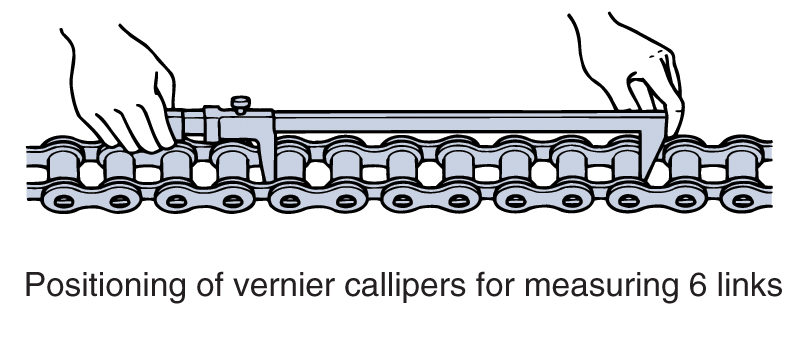

Fig. 31. Measuring length
- (4)Finding chain elongation.
Chain elongation = Measured length - Standard length Standard length × 100(%)
Standard length = Chain pitch × No. of links
- (5)For multi-strand roller chain, the measurement is carried out in the same way as for single strand roller chain of the same pitch.
- (6)The limit of usage based on roller chain elongation for a smooth transmission is as follows.
Limit of usage based on elongation Large sprocket number of teeth Chain elongation Up to 60 teeth 1.5% 61 to 80 teeth 1.2% 81 to 100 teeth 1.0% 101~110 0.8% - (7)Dimensions for evaluating standard length (chain pitch × number of links) and 1.5% elongation are shown in the table below.
- (8)When the length of the roller chain cannot be measured with calipers, a tape measure may be used; however, measurements need to be taken over as many links as possible to reduce measuring error.
- (9)When chain elongation of Lambda/Long Life Lambda Roller Chain reaches about 0.5% it may be losing its lubricating properties. This may be determined by the adhesion of red wear particles between the plates and the occurrence of articulation stiffness.
Standard length and 1.5% elongation 6 links measured 10 links measured Standard length Measured length Standard length Measured length RS25 38.10 38.67 63.50 64.45 RS35 57.15 58.01 95.25 96.68 RS41 76.20 77.34 127.00 128.91 RS40 76.20 77.34 127.00 128.91 RS50 95.25 96.68 158.75 161.13 RS60 114.30 116.01 190.50 193.36 RS80 152.40 154.69 254.00 257.81 RS100 190.50 193.36 317.50 322.26 RS120 228.60 232.03 381.00 386.72 RS140 266.70 270.70 444.50 451.17 RS160 304.80 309.37 508.00 515.62 RS180 342.90 348.04 571.50 580.07 RS200 381.00 386.72 635.00 644.53 RS240 457.20 464.06 762.00 773.43
7.4 Inspection of lifting and shuttle traction
- 1. This should be carried out with the same requirements as for ordinary transmission shown in item 7.3.
- 2. It is important to check the lubrication of the connecting parts between the roller chain and end brackets where end brackets are installed, as well as the parts where the roller chain winds around the sprocket.
- 3. The parts where the roller chain bends around the sprocket should be checked when inspecting the wear elongation of the roller chain.
- 4. Inspect for twisting and side bending of the roller chain. If partial twisting or side bending of the chain occurs, the complete roller chain should be replaced. (Fig. 32)
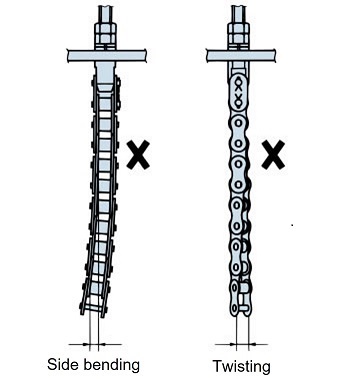
Fig. 32. Twisting of the roller chain
- 5. End fixtures
Check for wear, deformation, or other damage to the connecting-part holes. If the hole is damaged or deformed, replace the end bracket immediately.
The clearance on the pinhole of the bracket affects the life of the roller chain and should be kept to a minimum.
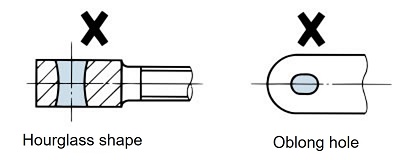
7.5 Storage
Avoid storing spare parts, such as roller chains, sprockets, and end brackets, in high temperature/high humidity and dusty environments.
Also, when storing roller chain that has been removed, wash the roller chain and then apply lubrication. After the roller chain clearances have been supplied with a sufficient amount of lubricant, wrap the chain in grease paper completely before storing away.

